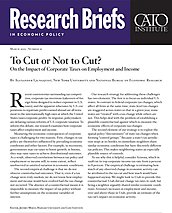Recent controversies surrounding tax competition, corporate tax inversions (takeovers of foreign firms designed to reduce exposure to U.S. taxes), and the apparent reluctance by U.S. corporations to repatriate profits earned abroad are all testament to the internationally high rates at which the United States taxes corporate profits. In response, policymakers are debating various reforms of U.S. corporate taxation. To inform this debate, our research examines how corporate taxes affect employment and income.
Measuring the economic consequences of corporate taxes is challenging for two reasons. First, changes in tax policy are themselves influenced by prevailing economic conditions and other factors. For example, in recessions, governments may cut taxes to boost growth; in booms, they may raise taxes to achieve distributional outcomes. As a result, observed correlations between tax policy and employment or income will, to some extent, reflect unobserved or omitted variation in economic conditions.
The second empirical challenge is that we do not observe counterfactual outcomes. That is, even if a tax change were truly random, we do not know how employment and income would have evolved had the tax change not occurred. The absence of a counterfactual means it is impossible to measure the impact of tax policy without further assumptions on the economic variables of interest.
Our research strategy for addressing these challenges has two elements. The first is to focus on individual U.S. states. In contrast to federal corporate tax changes, which affect all firms at the same time, state-level tax changes are staggered across states so that in a given year, some states are “treated” with a tax change while others are not. This helps deal with the problem of establishing a plausible counterfactual against which to measure the economic effects of corporate tax changes.
The second element of our strategy is to exploit the spatial policy “discontinuity” of state tax changes when forming “control groups.” Because a state’s tax jurisdiction stops at its border, its immediate neighbors share similar economic conditions but have discretely different tax policies. This makes neighboring states an especially plausible source of controls.
To see why this is helpful, consider Arizona, which in 1998 cut its top corporate income tax rate from 9 percent to 8 percent. The empirical challenge is estimating how much of any observed change in economic activity can be attributed to the tax cut and how much would have happened anyway. We might look to Utah to provide this counterfactual. Utah did not change tax rates in 1998, but being a neighbor arguably shared similar economic conditions. Arizona’s increases in employment and income, over and above those in Utah, provide an estimate of the tax cut’s impact on economic activity.
We further refine this “differences approach” by comparing not neighboring states but contiguous counties located on either side of a state border. This deals with the possibility that states vary their tax rates for reasons that correlate with unobserved changes in economic conditions. By comparing economic outcomes in neighboring counties straddling a state border, we can eliminate the effects of unobserved local variation in economic conditions that might correlate with the tax change.
Our sample of corporate income tax changes consists of 140 tax increases and 131 tax cuts in 45 states (including Washington, D.C.) affecting a total of 3,390 border-county years going back to 1969. Using these tax changes, we show that higher corporate taxes hurt employment and income in treated counties. Our point estimates suggest that all else equal, a one percentage-point increase in the top marginal corporate income tax rate reduces employment by between 0.3 percent and 0.5 percent and income by between 0.3 percent and 0.6 percent, measured relative to neighboring counties on the other side of the state border.
These estimates are remarkably stable: they remain essentially unchanged regardless of local characteristics such as the flexibility of local labor markets, income levels, population density, or the prevalence of small businesses in a county. They are also stable across the business cycle.
Interestingly, the effect of corporate tax changes is asymmetric. While tax increases are uniformly harmful, tax cuts have, in general, no significant effect on either employment or income. The exception is when tax cuts are implemented during a recession; then, tax cuts lead to sizable increases in employment and income. This suggests that corporate tax cuts, when used countercyclically, can be an effective tool if government desires to stimulate employment and income during economic downturns.
A question not fully answered by our results is how employment and income might respond if the federal government changed corporate income taxes. Extrapolating from our state-level estimates would require a structural model of the macro economy. This model would need to capture interactions and feedback effects among economic conditions and policies that are effectively held constant in our local comparison of border-county pairs. For example, a federal tax change may prompt the Federal Reserve to change monetary policy, with knock-on effects on long-term interest rates, inflation expectations, and exchange rates. Developing such a model is an important task for future work.
NOTE
This research brief is based on Alexander Ljungqvist and Michael Smolyansky, “To Cut or Not to Cut? On the Impact of Corporate Taxes on Employment and Income,” http://papers. ssrn.com/sol3/papers.cfm?abstract_id=2536677; all references are provided therein.
